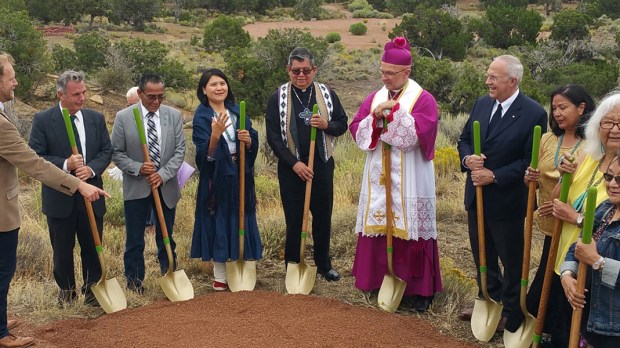St. Kateri Tekakwitha spent her short life in what is now New York State and Quebec Province, having been introduced to the Catholic faith by French missionaries. But her name is being proudly used for a new shrine in New Mexico, where Spanish friars led many Native Americans to the faith in the 16th and 17th centuries.
The choice of her patronage is not the result of some kind of cultural ignorance, but due to the fact that St. Kateri is patron saint of Native Americans. People like Bishop James S. Wall of Gallup, New Mexico, Carl Anderson of the Knights of Columbus, and William McCarthy of the Southwest Indian Foundation believe Native Americans can really use her heavenly intercession right now.
They know they can also use some real practical help as well.
When they thrust shovels into the desert earth outside of Gallup on Sunday to break ground for a major new American shrine, they knew they were well on the way to providing both.
Bishop Wall, Anderson, McCarthy, and Fr. Henry Sands, director of the National Black and Indian Foundation, were joined by tribal representatives at the ceremony to kick off the new Shrine of St. Kateri Tekakwitha, to be built on the grounds of the diocesan Sacred Heart Retreat House. The shrine will feature a larger-than-life Rosary walk.
“This Rosary walk will imitate the example of St. Kateri’s life, and we will take advantage of the natural beauty that God offers to us, as the Rosary will wind its way through the beautiful landscape that he’s already given to us,” Bishop Wall told a gathering at Sunday’s groundbreaking. “We will rely on the intercession of Our Lady, under the title of Our Lady of Guadalupe, who we know first appeared to an Indigenous person, that being St. Juan Diego. And so this shrine will be a special place for everyone, but especially to the indigenous people of this land, the Native American peoples of this land.”
The project was announced at the Knights of Columbus Supreme Convention in Minneapolis last week.
“Some indigenous peoples of North America embraced the Catholic faith long before many of our ancestors set foot on these shores,” Anderson said. “Today, in the United States, as many as one in four Native Americans are Catholic. And yet, in many ways, these brothers and sisters in the faith have been forgotten. … Despite many hardships, neglect, and a history of brutality toward them, still they hold fast to our Catholic faith.”
Anderson said the Knights hope that in the years to come the St. Kateri Shrine will become a “national spiritual home for Native Americans and for all Catholics in North America.”
“They’re trying to do two things: evangelize the Native Americans through the intercession of St. Kateri and her example, and they’ve been trying to … get the attention of people to understand the needs of folks out there,” said Erik Bootsma, the architect on the project.
Native peoples in the southwest, on balance, live below the poverty level, McCarthy said in an interview, emphasizing that Gallup is the poorest diocese in the United States, “and the vast majority of those who live in the diocese are Native Americans.”
“The per capita income of the Navajo tribe, which is the largest tribe by far in our area, is under $10,000 per capita,” he said. “Massive unemployment, and then the people live in dwellings without running water, electricity, dirt floors. It’s a third world country, within the continental borders of the United States.”
To help alleviate that poverty, the Southwest Indian Foundation builds about 20 homes a year and installs cooking and heating stoves; provides scholarships for lower income, needy Native American children so they can go to parochial schools; runs homes for women and children who are victims of domestic violence, and provides alcohol counseling and emergency assistance in the areas of food, clothing, heating fuel, and temporary shelter. It also provides a national outlet for Native Americans to sell handmade goods. Profits go directly back to Native Americans themselves in the form of philanthropic programs.
The Rosary walk will consist of 23 small shrines, 20 of them for the different mysteries of the Rosary. “There’s a small shrine to Our Lady of Guadalupe, which is kind of a little link of the Rosary, then four different [groups of mysteries],” Bootsma explained in an interview. “Each decade has its own little shrine, and they’re all kind of using these little traditional niches or shrines that you’d find all over the place around Mexico on churches, etc.”
It was Spanish missionaries from Mexico who first preached the Gospel in the area, not long after the apparitions of Our Lady of Guadalupe in Mexico City in 1531.
He said that native artists and local artists will be designing each niche, using glazed tile as their materials. Each niche will cost about $10,000 to build, and the walk is expected to be completed by August 2021.
“People can come and pray the Rosary every day and take a different path each day,” Bootsma said.
Said Bishop Wall, “My prayer for everyone who visits this—especially the Native American peoples—is that you come and walk and pray the Rosary walk, and as you leave the Rosary walk, that your faith might be strengthened, and your hope might be strengthened in the world to come.”

